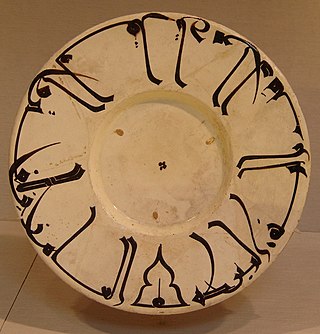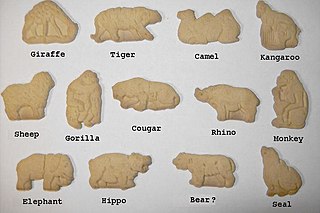
A cookie, or a biscuit, is a baked or cooked snack or dessert that is typically small, flat and sweet. It usually contains flour, sugar, egg, and some type of oil, fat, or butter. It may include other ingredients such as raisins, oats, chocolate chips, nuts, etc.

Oreo is a brand of sandwich cookie consisting of two cocoa biscuits or cookie pieces with a sweet fondant filling. It was introduced by Nabisco on March 6, 1912, and through a series of corporate acquisitions, mergers and splits both Nabisco and the Oreo brand have been owned by Mondelez International since 2012. Oreo cookies are available in over one hundred countries. Many varieties of Oreo cookies have been produced, and limited-edition runs have become popular in the 21st century.

A biscuit, in most English speaking countries, is a flour-based baked and shaped food product. Biscuits are typically hard, flat, and unleavened. They are usually sweet and may be made with sugar, chocolate, icing, jam, ginger, or cinnamon. They can also be savoury, similar to crackers. Types of biscuit include sandwich biscuits, digestive biscuits, ginger biscuits, shortbread biscuits, chocolate chip cookies, chocolate-coated marshmallow treats, Anzac biscuits, biscotti, and speculaas.

Earthenware is glazed or unglazed nonvitreous pottery that has normally been fired below 1,200 °C (2,190 °F). Basic earthenware, often called terracotta, absorbs liquids such as water. However, earthenware can be made impervious to liquids by coating it with a ceramic glaze, and is used for the great majority of modern domestic earthenware. The main other important types of pottery are porcelain, bone china, and stoneware, all fired at high enough temperatures to vitrify. End applications include tableware and decorative ware such as figurines.

A jar is a rigid, cylindrical or slightly conical container, typically made of glass, ceramic, or plastic, with a wide mouth or opening that can be closed with a lid, screw cap, lug cap, cork stopper, roll-on cap, crimp-on cap, press-on cap, plastic shrink, heat sealed lidding film, an inner seal, a tamper-evident band, or other suitable means. The English word "jar" originates from the Arabic word jarra, which means an earthen pot or vessel.

A cookie cutter in North American English, also known as a biscuit cutter outside North America, is a tool to cut out cookie/biscuit dough in a particular shape.

Biscuit tins are utilitarian or decorative containers used to package and sell biscuits and some confectionery. Invented by Huntley & Palmers in 1831, they are commonly found in households in Great Britain, Ireland, and Commonwealth countries, but also in continental Europe and French Canada. Popularity in the United States and English Canada spread later in the 20th century. Over 60% of UK households own a biscuit tin.

A tea caddy is a box, jar, canister, or other receptacle used to store tea. When first introduced to Europe from Asia, tea was extremely expensive, and kept under lock and key. The containers used were often expensive and decorative, to fit in with the rest of a drawing-room or other reception room. Hot water was carried up from the kitchen, and the tea made by the mistress of the house, or under her supervision.

A tin box is a tinplate container. Tinplate metal is primarily steel with a very thin tin coating. Tin-free steel is also used. In some cultures, these boxes or cans are referred to as "tin boxes" or sometimes even "tins". Many “tin boxes” have hinged or removable lids or covers. Some people collect tin boxes as a hobby.

A Mason jar, also known as a canning jar or fruit jar, is a glass jar used in home canning to preserve food. It was named after American tinsmith John Landis Mason, who patented it in 1858. The jar's mouth has a screw thread on its outer perimeter to accept a metal ring or "band". The band, when screwed down, presses a separate stamped steel disc-shaped lid against the jar's rim.

Glass milk bottles are glass bottles used for milk. They are generally reusable and returnable - used mainly for doorstep delivery of fresh milk by milkmen. Once customers have finished the milk, empty bottles are expected to be rinsed and left on the doorstep for collection, or rinsed bottles may be returned to a participating retail store. Bottle sizes vary depending on region, but common sizes include pint, quart or litre.

Christmas cookies or Christmas biscuits are traditionally sugar cookies or biscuits cut into various shapes related to Christmas.

An animal cracker is a particular type of cracker, baked in the shape of an animal, usually an animal either at a zoo or a circus, such as a lion, a tiger, a bear, or an elephant. The most common variety is light-colored and slightly sweet, but darker chocolate-flavored and colorful frosted varieties are also sold. Although animal crackers tend to be sweet in flavor like cookies, they are made with a layered dough like crackers and are marketed as crackers and not cookies.

Ceramic glaze, or simply glaze, is a glassy coating on ceramics. It is used for decoration, to ensure the item is impermeable to liquids and to minimise the adherence of pollutants.
This is a list of pottery and ceramic terms.

Cookie decorating dates back to at least the 14th century when in Switzerland, springerle cookie molds were carved from wood and used to impress Biblical designs into cookies.
A medicinal jar, drug jar, or apothecary jar is a jar used to contain medicines. Ceramic medicinal jars originated in the Islamic world and were brought to Europe where the production of jars flourished from the Middle Ages onward. Potteries were established throughout Europe and many were commissioned to produce jars for pharmacies and monasteries. They are an important category of the Dutch and English porcelain known as Delftware.

Ceramic art is art made from ceramic materials, including clay. It may take varied forms, including artistic pottery, including tableware, tiles, figurines and other sculpture. As one of the plastic arts, ceramic art is a visual art. While some ceramics are considered fine art, such as pottery or sculpture, most are considered to be decorative, industrial or applied art objects. Ceramic art can be created by one person or by a group, in a pottery or a ceramic factory with a group designing and manufacturing the artware.




















